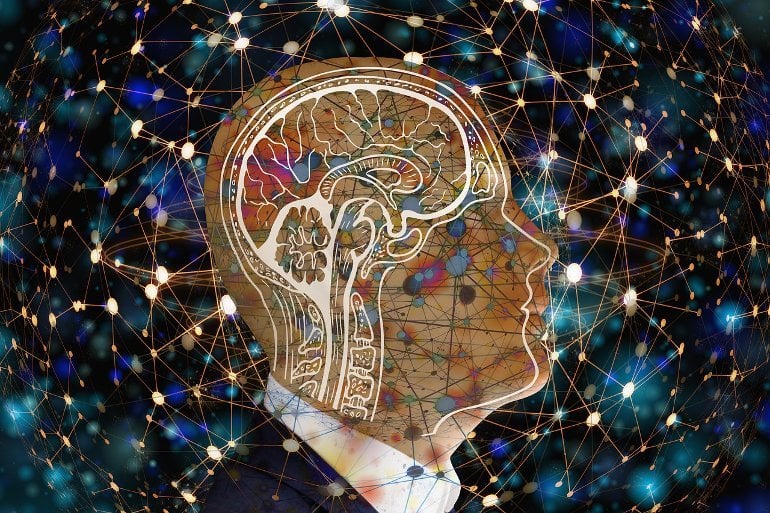Summary: A new method that targets the astrocytes surrounding glioblastoma brain cancer eradicates tumor cells and extends lifespan in animal models.
Source: Tel Aviv University
A groundbreaking study at Tel Aviv University effectively eradicated glioblastoma, a highly lethal type of brain cancer.
The researchers achieved the outcome using a method they developed based on their discovery of two critical mechanisms in the brain that support tumor growth and survival: one protects cancer cells from the immune system, while the other supplies the energy required for rapid tumor growth.
The work found that both mechanisms are controlled by brain cells called astrocytes, and in their absence, the tumor cells die and are eliminated.
The study was led by Ph.D. student Rita Perelroizen, under the supervision of Dr. Lior Mayo of the Shmunis School of Biomedicine and Cancer Research and the Sagol School of Neuroscience, in collaboration with Prof. Eytan Ruppin of the National Institutes of Health (NIH) in the U.S.
The paper was published in the journal Brain and was highlighted with special commentary.
The researchers explain, “Glioblastoma is an extremely aggressive and invasive brain cancer, for which there exists no known effective treatment. The tumor cells are highly resistant to all known therapies, and, sadly, patient life expectancy has not increased significantly in the last 50 years.
“Our findings provide a promising basis for the development of effective medications for treating glioblastoma and other types of brain tumors.”
Dr. Mayo says, “Here, we tackled the challenge of glioblastoma from a new angle. Instead of focusing on the tumor, we focused on its supportive microenvironment, that is, the tissue that surrounds the tumor cells. Specifically, we studied astrocytes—a major class of brain cells that support normal brain function, discovered about 200 years ago and named for their starlike shape.
“Over the past decade, research from us and others revealed additional astrocyte functions that either alleviate or aggravate various brain diseases. Under the microscope we found that activated astrocytes surrounded glioblastoma tumors. Based on this observation, we set out to investigate the role of astrocytes in glioblastoma tumor growth.”
Using an animal model, in which they could eliminate active astrocytes around the tumor, the researchers found that in the presence of astrocytes, the cancer killed all animals with glioblastoma tumors within 4-5 weeks.
Applying a unique method to specifically eradicate the astrocytes near the tumor, they observed a dramatic outcome: the cancer disappeared within days, and all treated animals survived. Moreover, even after discontinuing treatment, most animals survived.
Dr. Mayo says, “In the absence of astrocytes, the tumor quickly disappeared, and in most cases, there was no relapse—indicating that the astrocytes are essential to tumor progression and survival. Therefore, we investigated the underlying mechanisms: How do astrocytes transform from cells that support normal brain activity into cells that support malignant tumor growth?”
To answer these questions, the researchers compared the gene expression of astrocytes isolated from healthy brains and from glioblastoma tumors.
They found two main differences—thereby identifying the changes that astrocytes undergo when exposed to glioblastoma. The first change was in the immune response to glioblastoma.
“The tumor mass includes up to 40% immune cells—mostly macrophages recruited from the blood or from the brain itself. Furthermore, astrocytes can send signals that summon immune cells to places in the brain that need protection.
“In this study, we found that astrocytes continue to fulfill this role in the presence of glioblastoma tumors. However, once the summoned immune cells reach the tumor, the astrocytes ‘persuade’ them to ‘change sides’ and support the tumor instead of attacking it.
“Specifically, we found that the astrocytes change the ability of recruited immune cells to attack the tumor both directly and indirectly—thereby protecting the tumor and facilitating its growth,” says Dr. Mayo.
The second change through which astrocytes support glioblastoma is by modulating their access to energy—via the production and transfer of cholesterol to the tumor cells.
Dr. Mayo: “The malignant glioblastoma cells divide rapidly, a process that demands a great deal of energy. With access to energy sources in the blood barred by the blood-brain barrier, they must obtain this energy from the cholesterol produced in the brain itself—namely in the astrocytes’ ‘cholesterol factory,’ which usually supplies energy to neurons and other brain cells.
“We discovered that the astrocytes surrounding the tumor increase the production of cholesterol and supply it to the cancer cells. Therefore, we hypothesized that, because the tumor depends on this cholesterol as its main source of energy, eliminating this supply will starve the tumor.”
Next, the researchers engineered the astrocytes near the tumor to stop expressing a specific protein that transports cholesterol (ABCA1), thereby preventing them from releasing cholesterol into the tumor.
Once again, the results were dramatic: with no access to the cholesterol produced by astrocytes, the tumor essentially “starved” to death in just a few days.
These remarkable results were obtained in both animal models and glioblastoma samples taken from human patients and are consistent with the researchers’ starvation hypothesis.
Dr. Mayo notes, “This work sheds new light on the role of the blood-brain barrier in treating brain diseases. The normal purpose of this barrier is to protect the brain by preventing the passage of substances from the blood to the brain. But in the event of a brain disease, this barrier makes it challenging to deliver medications to the brain and is considered an obstacle to treatment.

“Our findings suggest that, at least in the specific case of glioblastoma, the blood-brain barrier may be beneficial to future treatments, as it generates a unique vulnerability—the tumor’s dependence on brain-produced cholesterol. We think this weakness can translate into a unique therapeutic opportunity.”
The project also examined databases from hundreds of human glioblastoma patients and correlated them with the results described above.
The researchers explain, “For each patient, we examined the expression levels of genes that either neutralize the immune response or provide the tumor with a cholesterol-based energy supply. We found that patients with low expression of these identified genes lived longer, thus supporting the concept that the genes and processes identified are important to the survival of glioblastoma patients.”
Dr. Mayo concludes, “Currently, tools to eliminate the astrocytes surrounding the tumor are available in animal models, but not in humans. The challenge now is to develop drugs that target the specific processes in the astrocytes that promote tumor growth. Alternately, existing drugs may be repurposed to inhibit mechanisms identified in this study.
“We think that the conceptual breakthroughs provided by this study will accelerate success in the fight against glioblastoma. We hope that our findings will serve as a basis for the development of effective treatments for this deadly brain cancer and other types of brain tumors.”
About this brain cancer research news
Author: Press Office
Source: Tel Aviv University
Contact: Press Office – Tel Aviv University
Image: The image is in the public domain
Original Research: Closed access.
“Astrocyte immunometabolic regulation of the tumour microenvironment drives glioblastoma pathogenicity” by Rita Perelroizen et al. Brain
Closed access.
“Forced but effective partners in crime: how astrocytes drive the progression of glioblastoma” by Kai Murk et al. Brain
Abstract
Astrocyte immunometabolic regulation of the tumour microenvironment drives glioblastoma pathogenicity
Malignant brain tumours are the cause of a disproportionate level of morbidity and mortality among cancer patients, an unfortunate statistic that has remained constant for decades. Despite considerable advances in the molecular characterization of these tumours, targeting the cancer cells has yet to produce significant advances in treatment.
An alternative strategy is to target cells in the glioblastoma microenvironment, such as tumour-associated astrocytes. Astrocytes control multiple processes in health and disease, ranging from maintaining the brain’s metabolic homeostasis, to modulating neuroinflammation. However, their role in glioblastoma pathogenicity is not well understood.
Here we report that depletion of reactive astrocytes regresses glioblastoma and prolongs mouse survival.
Analysis of the tumour-associated astrocyte translatome revealed astrocytes initiate transcriptional programmes that shape the immune and metabolic compartments in the glioma microenvironment. Specifically, their expression of CCL2 and CSF1 governs the recruitment of tumour-associated macrophages and promotes a pro-tumourigenic macrophage phenotype.
Concomitantly, we demonstrate that astrocyte-derived cholesterol is key to glioma cell survival, and that targeting astrocytic cholesterol efflux, via ABCA1, halts tumour progression. In summary, astrocytes control glioblastoma pathogenicity by reprogramming the immunological properties of the tumour microenvironment and supporting the non-oncogenic metabolic dependency of glioblastoma on cholesterol.
These findings suggest that targeting astrocyte immunometabolic signalling may be useful in treating this uniformly lethal brain tumour.
Abstract
Forced but effective partners in crime: how astrocytes drive the progression of glioblastoma
Glioblastoma multiforme (GBM) is the most common and malignant glioma in adults. Patients diagnosed with GBM face the dismal prognosis of a median life expectancy of ∼15 months.
As the tumours progress, patients are likely to experience severe complications, such as epileptic seizures, peritumoural oedema, and intracranial hypertension.
The extreme aggressiveness of GBM is the result of several pathological features. For instance, GBM spreads diffusely throughout the CNS, enabling it to escape surgical interventions.
When GBM pushes its way through the parenchyma, it causes severe tissue damage and disrupts CNS functions. Moreover, GBM is effective at withstanding conventional radiation and chemotherapies.






